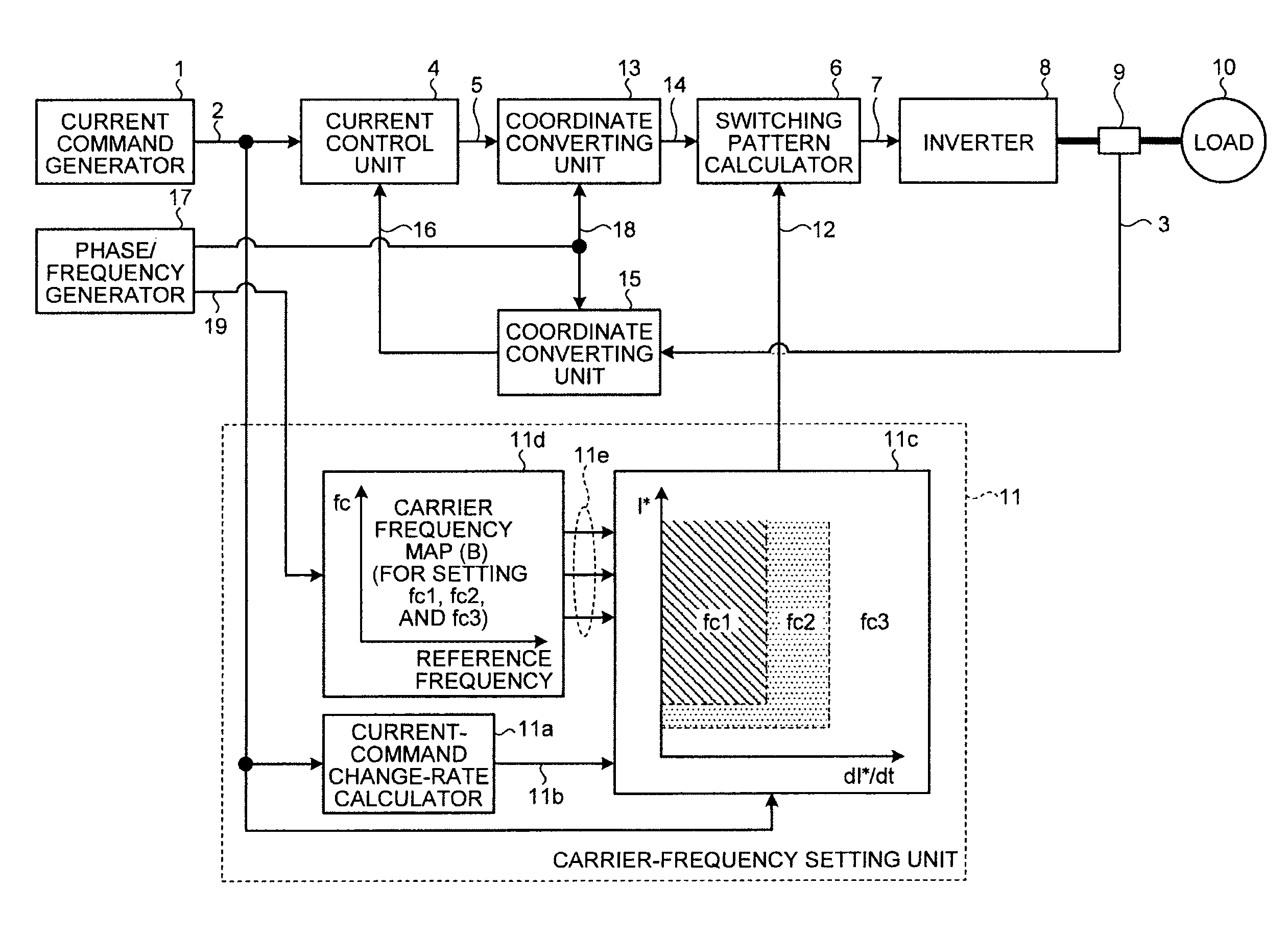Controller of power converter
a power converter and control panel technology, applied in the direction of dynamo-electric converter control, pulse technique, instruments, etc., can solve the problems of increasing the switching loss of the inverter, increasing the switching loss of the semiconductor switching element, and increasing electromagnetic noise, so as to achieve the effect of stably changing the carrier frequency, current-control response enhancement and loss suppression of the inverter
- Summary
- Abstract
- Description
- Claims
- Application Information
AI Technical Summary
Benefits of technology
Problems solved by technology
Method used
Image
Examples
first embodiment
(Configuration of Controller)
[0062]A configuration of a controller of a power converter according to a first embodiment, that is, the configuration of the controller according to the first embodiment to control the power converter, is explained first. FIG. 1 depicts the configuration of the controller of a power converter according to the first embodiment of the present invention. An inverter, a load connected to the inverter, and a current detector are also illustrated in FIG. 1 for explanation.
[0063]In FIG. 1, the controller according to the present embodiment includes a current command generator 1, a current control unit 4 and a carrier-frequency setting unit 11 to which an output signal of the current command generator 1 is input, and a switching pattern calculator 6 to which an output signal of the current control unit 4 and an output signal of the carrier-frequency setting unit 11 are input. The carrier-frequency setting unit 11 includes a current-command change-rate calculato...
second embodiment
[0082]FIG. 6 depicts a configuration of a controller of a power converter according to a second embodiment of the present invention. Particularly in the present embodiment, an alternate current load such as an alternate current motor and the like is assumed as the load 10, to explain an effect of the present embodiment in more detail. Because the load 10 is an alternate current load, in the present embodiment, coordinate converting units 13 and 15 are further provided in addition to the configuration of the first embodiment shown in FIG. 1. The second embodiment is also different from the first embodiment in that a phase / frequency generator 17 is provided and that a carrier frequency map 11d is provided in the carrier-frequency setting unit 11. Other constituent elements of the second embodiment are identical or equivalent to those illustrated in FIG. 1, and these elements are denoted by like reference letters or numerals.
[0083]The detection current signal 3 is converted into a dete...
third embodiment
[0091]FIG. 7 depicts a configuration of a controller of a power converter according to a third embodiment of the present invention. In the present embodiment, a carrier frequency is decreased while keeping a response characteristic of a current control system at a predetermined value, thereby reducing a switching loss of an inverter.
[0092]In the present embodiment, in addition to the configuration of the first embodiment illustrated in FIG. 1, a current-control-response setting unit 20 is provided, and a carrier frequency map 11f and a current-control-response-command correction-signal setting unit 11g are provided within the carrier-frequency setting unit 11. Other constituent elements of the third embodiment are identical or equivalent to those illustrated in FIG. 1, and these elements are denoted by the same reference letters or numerals as in FIG. 1.
[0093]The current-control-response setting unit 20 sets and outputs an appropriate current-control response command 21 correspondin...
PUM
 Login to View More
Login to View More Abstract
Description
Claims
Application Information
 Login to View More
Login to View More - R&D
- Intellectual Property
- Life Sciences
- Materials
- Tech Scout
- Unparalleled Data Quality
- Higher Quality Content
- 60% Fewer Hallucinations
Browse by: Latest US Patents, China's latest patents, Technical Efficacy Thesaurus, Application Domain, Technology Topic, Popular Technical Reports.
© 2025 PatSnap. All rights reserved.Legal|Privacy policy|Modern Slavery Act Transparency Statement|Sitemap|About US| Contact US: help@patsnap.com



